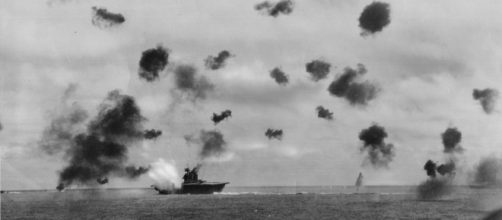The Battle Of Midway, which took place 75 years ago, is rightly regarded as having turned the tide in the Pacific War, ensuring that the Japanese could never score a knockout blow against the American Pacific Fleet and force a negotiated peace. The Action took place when an American force of three aircraft carrier battle groups ambushed a Japanese fleet built around four carriers that were supporting an invasion of Midway Island, a military base in the middle of the Pacific.
Through raw courage and no little luck, the American fleet won the day, sinking all four Japanese carriers against the loss of one of their own.
The loss of pilots was horrendous. But Midway had become a decisive, war changing naval battle that ranks next to the Battle of Salamis and the fight against the Spanish Armada. It may be useful to how the technology of the time shaped the battle.
Midway was a fight between two fleets hundreds of miles away
Up until World War Ii, naval combat consisted of two fleets fighting within sight of one another. From galleys smashing into one another to wooden battleships pouring broadsides against one another to dreadnaughts lobbing shells over miles, the two opposing fleets fought by the line of sight.
World War II was different. In the Pacific, starting with Pearl Harbor, Naval fleets made their fury known from hundreds of miles away, sending waves of aircraft, dive bombers, torpedo bombers, and fighter craft to strike at targets no one on the attacking ships could see.
The Battle of the Coral Sea was the first carrier battle in which two fleets fought without being in visual contact with one another.
The problem with fighting the enemy at sea is finding him
Midway was fought long before satellite reconnaissance, long-range radar, or GPS. The way that the two opposing fleets tried to find one another was to send long-range reconnaissance aircraft along a wide-ranging search area to hunt for the other fleet by visual contact.
Once the enemy fleet was located, the position, heading, and speed was radioed back, and then the combat aircraft were launched.
Communications and navigation snafus made coordinating attacks a dicey operation. American torpedo bombers attempted attack runs on the Japanese fleet without fighter escort and were slaughtered as a result.
But these attacks placed the Japanese air cover out of position to oppose the belated arrival of American dive bombers who caught the Japanese carriers just as planes were being reloaded with bombs. Three carriers were set ablaze within minutes.
While the fourth Japanese carrier and the American carrier USS Yorktown were sunk later, those few minutes were decisive. The Japanese fleet never recovered and, by the following year, American production capacity achieved overwhelming naval superiority in the Pacific. After Midway, Japan ultimate defeat was only a matter of time and will.


